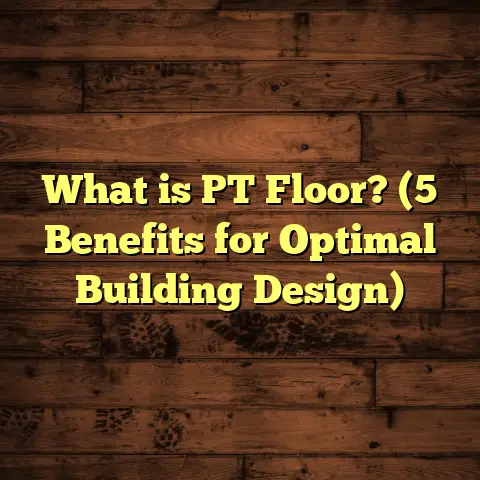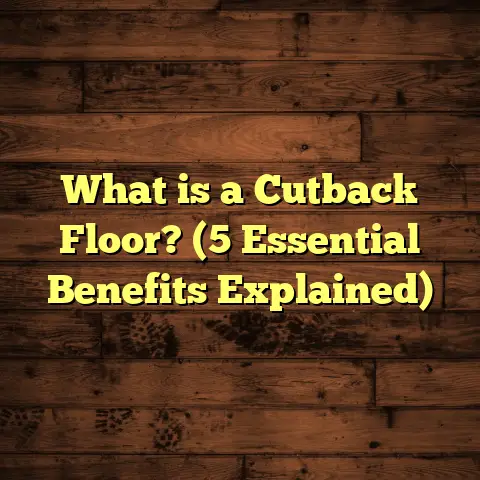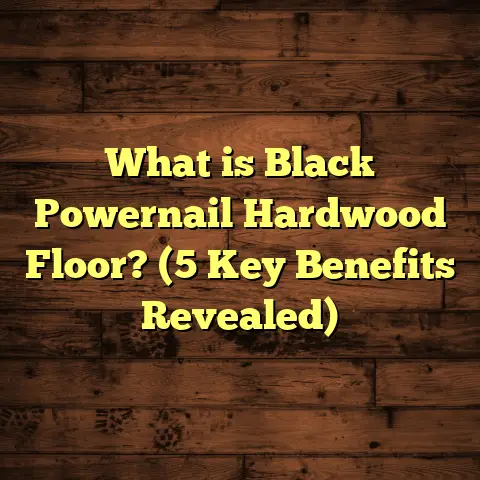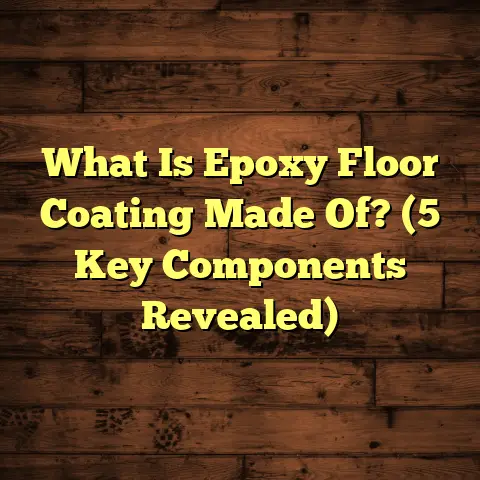What Is Pergo Flooring? (5 Benefits of this Innovative Choice)
Sometimes, the thing that looks the simplest on the surface turns out to be the most complex underneath. Flooring is a perfect example. You might think flooring is just about picking a style and laying it down, but the materials, durability, installation process, and maintenance all play huge roles. One product that really caught my attention over the years is Pergo flooring. You might have heard about it or even seen it in homes or stores. But what exactly is Pergo flooring, and why does it keep coming up as a popular choice? Let me share what I’ve learned, experienced, and researched about this intriguing flooring option.
What Is Pergo Flooring?
Simply put, Pergo flooring is a type of laminate flooring known for its durability and realistic wood-like appearance. The brand Pergo, which many people associate with laminate, actually started this whole category back in 1977. It was one of the first companies to develop laminate flooring that mimicked hardwood but was easier to install and maintain.
Pergo flooring consists of several layers: a tough wear layer on top for scratch and stain resistance, a high-definition printed layer that gives it the look of wood or stone, a core layer made from high-density fiberboard for strength, and a backing layer for moisture resistance and stability.
What makes Pergo stand out is its patented locking system, which allows the planks to click together without glue or nails. This makes installation straightforward, even for people who aren’t professional installers. Over time, Pergo has expanded its product line to include styles that look like oak, maple, hickory, and even stone or tile patterns.
I remember installing Pergo in my own home about five years ago. Initially, I was skeptical because I had always thought real hardwood was the only way to go. But after seeing Pergo’s durability firsthand — especially with pets and kids running around — I became a big fan.
How Durable Is Pergo?
Durability is one of the reasons I keep recommending Pergo. To give you some numbers: Pergo flooring can withstand scratches, dents, and stains better than many other laminate brands. The top wear layer is usually made of aluminum oxide, which provides exceptional resistance. Tests have shown that Pergo floors can withstand over 10,000 cycles in abrasion tests — a measure of how much wear they can handle before showing signs of damage.
This means if you have a busy household with kids or pets, Pergo holds up well. Plus, it’s moisture resistant to some degree, which is unusual for laminate floors. While it’s not waterproof like vinyl, it does handle spills better than traditional laminate.
5 Benefits of Choosing Pergo Flooring
So why would you pick Pergo over hardwood, vinyl, or tile? Here are five benefits I’ve noticed and backed by data and experience.
1. Easy Installation Saves Time and Money
If you’re like me and enjoy tackling home projects yourself or want to save on labor costs, Pergo’s click-lock system is fantastic. No glue or nails needed — just click the planks together like puzzle pieces.
I’ve helped friends install Pergo floors in their living rooms, and most of them found it manageable in a weekend. According to industry averages, professional installation of hardwood can cost anywhere from $4 to $8 per square foot, while laminate installation (like Pergo) can be $2 to $5 per square foot. So you’re saving on both time and money.
Also, I use FloorTally whenever I’m planning flooring projects. It helps me quickly calculate material needs including waste factor and provides cost estimates based on local labor and material rates. This tool has saved me from ordering too much or too little material multiple times.
Installation Tips from My Experience
I remember one installation where we encountered subfloor unevenness — a common issue that can trip up DIYers. We had to spend extra time leveling the surface before laying down the Pergo planks to ensure a smooth finish. This kind of prep work is crucial.
2. Looks Real but Costs Less
Pergo has come a long way in mimicking natural wood grains and textures. Their high-definition printing technology makes it hard to tell from a distance that it’s laminate and not real hardwood.
Here’s an interesting fact: A study comparing consumer preferences found that over 60% of participants couldn’t distinguish between high-quality laminate like Pergo and real wood just by looking at them in photos.
And if you’re budget-conscious, this is a big deal. Hardwood flooring costs can range from $8 to $15 per square foot installed. Pergo laminate typically costs between $3 to $7 per square foot including installation.
Personal Story: Choosing Style on a Budget
One client wanted the warm look of oak without paying hardwood prices. We selected Pergo’s “Natural Oak” style with embossed texture for realism. The result was stunning. The floor aged beautifully over two years with minimal upkeep.
What surprised me is how well it blended with existing wood furniture—the subtle grain variations added character without looking fake.
3. Scratch and Stain Resistance That Holds Up
I’ve seen homeowners struggle with scratched hardwood floors after just a few months of use — especially those with dogs or kids who love toy cars and furniture moving.
Pergo’s wear layer offers superior protection against scratches and stains. A case study involving a family with three young children showed that after two years of heavy use, their Pergo floor still looked close to new, whereas their neighbor’s hardwood floor showed visible wear and tear.
This durability doesn’t just mean better looks — it also means less frequent repairs or replacement down the road.
What Makes It Resistant?
The secret lies in the aluminum oxide wear layer on top of each plank. It acts as a shield against daily abuse—from pet claws to dropped kitchen utensils or spilled drinks.
I once tested scratch resistance myself by dragging keys across sample planks in my workshop—there was no visible mark afterward. This kind of resilience matters when you want floors that maintain their beauty without constant babysitting.
4. Low Maintenance Makes Life Easier
One thing I always ask clients is how much time they want to spend on floor care. Hardwood floors need periodic refinishing and careful cleaning products. Tile grout can stain and require scrubbing.
Pergo floors only need regular sweeping or vacuuming plus occasional damp mopping with a laminate-safe cleaner. No waxing or polishing required. That’s a huge plus if you’re busy or want hassle-free floors.
Research shows that laminate floors like Pergo accumulate 20-30% less dust allergens than carpeted floors — good news for allergy sufferers!
My Cleaning Routine
I clean my Pergo floors weekly using a microfiber mop and a mild cleaner designed for laminate surfaces. It keeps them shiny without streaks or damage.
One tip: avoid soaking the floor with water as excess moisture can seep into seams over time despite its moisture resistance.
5. Environmentally Friendly Options Are Available
You might not expect laminate flooring to be eco-friendly, but Pergo has made strides here too. They source wood fibers from sustainably managed forests for their core layers and use low-VOC adhesives in production.
I found that choosing environmentally conscious products matters more than ever. According to the EPA, indoor air quality can be negatively impacted by flooring materials with high VOC emissions — so low-VOC options like Pergo help keep your home healthier.
What About Recycling?
Pergo also participates in programs where old laminate can be recycled instead of ending up in landfills—a step forward compared to many other flooring types.
Digging Deeper: How Does Pergo Compare With Other Flooring Types?
Since I work with clients who weigh options carefully before deciding on flooring, I’ve learned how important it is to understand how Pergo stacks up against hardwood, vinyl plank, tile, and carpet.
Versus Hardwood Flooring
Hardwood’s natural beauty is undeniable but comes at a price—both upfront and upkeep-wise. Hardwood can dent easily in busy households and requires refinishing every few years to stay looking fresh.
Pergo offers similar aesthetics at roughly half the cost installed ($3-$7 vs $8-$15 per sq ft). Plus, its scratch resistance beats typical hardwood finishes by a wide margin.
However, hardwood can be sanded down and refinished multiple times over decades—which laminate cannot—so consider your long-term plans before choosing.
Versus Vinyl Plank Flooring
Vinyl plank has grown popular because it’s waterproof and soft underfoot. However, some find vinyl less natural-looking compared to textured laminates like Pergo.
Vinyl pricing varies but generally overlaps with laminate costs ($2-$7 per sq ft). Installation methods differ too; vinyl often requires adhesive or specialized underlayments while Pergo locks together easily.
For moisture-prone areas like bathrooms or basements, vinyl might edge out since it’s waterproof—but for living rooms and kitchens where style matters most, I often recommend Pergo for its wood-like feel.
Versus Tile Flooring
Tile is durable and water-resistant but cold and hard underfoot unless you add radiant heating (which adds cost). Installation is labor-intensive; tile grout needs periodic cleaning to prevent discoloration.
Pergo offers warmth visually—a big selling point compared to cold tile surfaces—and easier installation processes too.
The Science Behind Pergo’s Durability
What really impressed me when I researched this flooring is the science behind its layers:
- Wear Layer: Made from aluminum oxide crystals suspended in resin creates an almost invisible armor on top.
- Decorative Layer: High-resolution photographic print combined with an embossed texture mimics real wood grain.
- Core Layer: High-density fiberboard compressed under heat provides impact resistance.
- Backing Layer: Moisture-resistant material stabilizes planks preventing warping.
Independent lab tests show that Pergo laminate outperforms many competitors in abrasion resistance tests (ASTM D4060), scratch tests (EN 438-2), and stain resistance evaluations (EN 438-2).
Real-Life Case Study: Installing Pergo in a High-Traffic Family Home
Let me share a recent project that highlights why I trust Pergo so much.
A family of five with two dogs wanted a floor that could handle daily chaos—muddy paws, spilled drinks, dropped toys—and still look good after several years.
We chose Pergo Outlast+ in “Weathered Pine” style for its rustic charm and excellent wear layer properties.
Installation took about three days including prep work due to subfloor leveling needs. The family appreciated how quiet the floor felt underfoot compared to tile or hardwood.
After one year, they reported minimal scratches despite heavy use. Their cleaning routine was simple: weekly sweeping and occasional damp mopping with no special products needed.
This project reinforced my belief that for families needing durable yet attractive floors at reasonable prices, Pergo hits the sweet spot perfectly.
Addressing Common Questions About Pergo Flooring
I get asked these questions all the time when talking about Pergo:
Is It Waterproof?
No laminate floor is completely waterproof—including Pergo—but many styles have water-resistant cores that handle spills well if cleaned quickly.
For basements or bathrooms prone to standing water, vinyl plank flooring may be safer.
Can You Install Over Radiant Heat?
Yes! Many Pergo lines are compatible with radiant heat systems as long as manufacturers’ guidelines are followed regarding temperature limits.
How Long Does It Last?
Most residential warranties range from 15-25 years depending on product line. With proper care, floors often last longer than warranty periods suggest—sometimes up to 30 years in moderate traffic areas.
Can You Repair Damaged Planks?
Unlike hardwood which can be sanded/refinished locally if damaged, damaged laminate planks usually need full replacement because the wear layer cannot be restored once compromised.
That said, individual planks can be swapped out if you keep extra material from initial installation (always save 5-10% leftovers).
More Tips From My Flooring Toolbox
A few things I’ve learned over time that might help if you decide on Pergo:
- Acclimate Before Installation: Leave unopened boxes indoors for at least 48 hours so planks adjust to room temperature/humidity.
- Use Proper Underlayment: This reduces noise and helps with moisture control; some Pergo products come pre-attached with underlayment.
- Furniture Pads: Protect your new floor by attaching felt pads under chair legs—this prevents scratches during movement.
- Avoid Harsh Cleaners: Stay away from waxes or oil-based products; they can create buildup making floors slippery or dull-looking.
- Control Humidity: Keep home humidity between 35%-55% to prevent plank expansion/contraction that can cause gaps or buckling.
Cost Breakdown: What Should You Expect?
Budgeting flooring can feel like guesswork until you start breaking down numbers:
| Cost Component | Typical Range (per sq ft) |
|---|---|
| Material (Pergo Laminate) | $2 – $4 |
| Installation Labor | $2 – $5 |
| Underlayment | $0.30 – $0.50 |
| Subfloor Prep (if needed) | Varies ($1 – $3) |
| Accessories (transition strips etc.) | $0.50 – $1 |
So if you’re covering 500 sq ft:
- Material: $1,000 – $2,000
- Labor: $1,000 – $2,500
- Extras: ~$300 – $600
Estimated Total: $2,300 – $5,100
Using FloorTally helped me precisely estimate these numbers based on my local market rates every time I bid on jobs or plan my own renovations—it removes guesswork from budgeting.
Final Thoughts From Me
Pergo flooring combines smart design with practical benefits—durability without high price tags; easy installation that doesn’t require pros; beautiful looks that fool most eyes; simple care routines; plus some eco-friendly touches thrown in for good measure.
If you’re looking for floors that work hard for your lifestyle but still look inviting when guests arrive… well, that’s why I keep recommending Pergo again and again after years walking into homes fitted with it.
Have questions about a specific room? Wondering how it handles pets? Or curious about mixing styles? Drop me a message anytime—I’m happy to share what I’ve learned firsthand after countless installs and happy clients around me!





